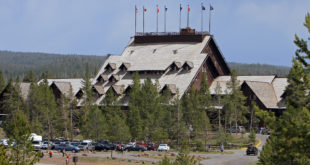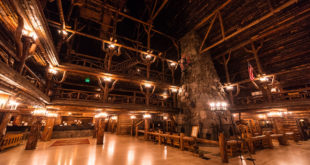Canyon Area
The Canyon Village area in Yellowstone National Park is known for three things. First, it is located near the Grand Canyon of Yellowstone (duh). Second, it has a really great place to go have a quick, malt-shop style meal. And lastly, it sports the newest Visitor Center in Yellowstone National Park.
Opening in 2008, the Canyon Area Visitor Center not only features visitor center standards such as an information desk, restrooms, drinking fountains and a store, but also it is also home to a mini-museum. Specifically, the mini-museum explores the science behind all the geothermal features in the park, as well as the super volcano that powers it all.
Even before you enter the visitor center, you are struck by the august rustic architecture, almost as if Robert Reamer was brought back to life to construct another piece of “parkitecture,” albeit with a newer, 21st-century twist and overtones reminiscent of Yellowstone’s Mission 66 project conducted in the late 1950s and mid 1960s. Once you enter the center itself, you are greeted by a visitor’s desk and a pair of bison, presumably a mother and her calf, nestled together, side-by-side. They are part of an exhibit about the ecology of bison in Yellowstone that is currently on site.
But what’s most impressive in the visitor center is the volcano exhibit. In the very center of the museum area on the first floor lies a huge map of Yellowstone National Park, detailing some of the geothermal features as well as the role of the caldera, or super volcano, itself. Also within the exhibit is a 4 ½ ton globe detailing hot spots all around the world, a lava lamp (yeah, a lava lamp. But it’s big!) that details how a heat convection cycle works, and a computer generated earthquake display. The Visitor Center also plans to put in a geology exhibit to supplement the other exciting exhibits.
The Canyon Village Visitor Center is one of the best and most interesting places to learn more about the park itself, but it’s also one of the best places to just stop and take a break before heading out on the road again. Whether you’re traveling alone, or with a family of twelve, the Canyon Village Visitor Center is sure to meet all your needs and demands. For more information, call 307.242.2550.
Lake, Bridge Bay and Fishing Bridge Visitor Facilities
The Fishing Bridge Museum and Visitor Center is located one mile off the Grand Loop Road on the East Entrance Road. The building itself is worth a look, built in 1931 as a Park Service structure; kids will enjoy the small exhibit of the birds of Yellowstone. There’s a Yellowstone Association book sales outlet, while Ranger Stations at Lake and Bridge Bay issue backcountry and boating permits as well as general park information. The phone number is 307.242.2450.
Madison Area Visitor Facilities
Located at Madison Junction in the Madison Picnic Area, the Madison Information Station and Yellowstone Association bookstore are open during the summer. The building itself is worth a look: built in 1929 and now designated as a National Historic Landmark, the wood-and-stone structure formerly housed a museum and an arts project. More famously, the building marks the site of a campfire where members of the Washburn-Langford-Doane Expedition allegedly hatched the plan to designate Yellowstone as a national park. It may be a legend, but it’s also a good story.
Mammoth Area
If you visit only one visitor center in Yellowstone National Park, make it a jaunt to Albright Visitor Center and Museum. Located five miles south of the North Entrance in the Mammoth Hot Springs area, the Albright Visitor Center and Museum covers the entire history of the park. It’s housed in what was Fort Yellowstone, built by the U.S. Cavalry near the turn of century to house soldiers combating poaching and other illegal activities in the park. The Army left in 1916, but the buildings were converted to Park Service facilities.
Today the former quarters for bachelors is the Albright Visitor Center and Museum, with a focus on the history of the park. You’ll learn how Native Americans treated the park — they tended to avoid it, as it ends up — and see how things changed when the mountain men made their first excursions in the park in the early 1800. Their wild stories of an exploding land led to formal scouting expeditions in 1869 through 1871; those reports led the establishment of Yellowstone as the first national park. Kids will enjoy exhibits in the wildlife of Yellowstone, while adults can browse through exhibits featuring reproductions of Thomas Moran watercolors and original photos by William Henry Jackson, who was part of the 1871 Hayden Survey. If the family needs a break, two films are shown in a small theater: The Challenge of Yellowstone covers the history of Yellowstone and Thomas “Yellowstone” Moran explains how key Moran’s artwork was in the creation of Yellowstone National Park. They’re shown continuously in the summer, on demand the rest of the year.
It features a Yellowstone Association book sales outlet. Also, a Backcountry Office issues camping, boating and fishing permits.
During most of the year you can see elk wandering through the grounds (beware, though — they’re not as tame as they look). It’s always open (except for Veterans’ Day and Thanksgiving Day), even in winter.
Norris Geyser Basin and Museum
The complex is located a quarter-mile east of Norris Junction. just off the Grand Loop Road. It’s one of the busiest in the park, serving as the gateway to the popular Norris Geyser Basin. The museum covers some basics on geothermal activity and the basin highlights, including Steamboat Geyser and Echinus Geyser. Also in the area: an information desk, pit restrooms and a Yellowstone Association bookstore. Nearby at the entrance to Norris Campground is the Museum of the National Park Ranger, which shows the development of the park ranger profession from its roots in the military traditions through early rangers and present-day rangers.
Old Faithful Visitor Center
Most people assume Old Faithful Inn is the visitor center, but it’s not. There’s a temporary visitor center near the Old Faithful Lodge, and currently under construction is a new visitor center.
Tower-Roosevelt Area Visitor Facilities
There’s no visitor center per se in the Tower-Roosevelt area. However, there are three ranger stations in the Tower District, located at Tower Junction (backcountry and fishing permits), the Lamar Buffalo Ranch (emergency visitor services only), and the Northeast Entrance station.
West Thumb and Grant Village Visitor Facilities
Located on the shore of the West Thumb of Yellowstone Lake one mile off of the main park road at Grant Village Junction, this complex includes the West Thumb Information Station, with the Division of Resource Management and Visitor Protection operating the backcountry office. Also in the complex: a Yellowstone Association book outlet and an exhibit detailing fire’s role in the Yellowstone environment.
 Yellowstone Insider Your Complete Guide to America's First National Park
Yellowstone Insider Your Complete Guide to America's First National Park





